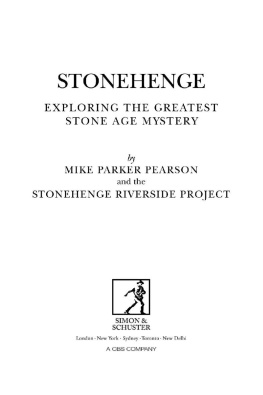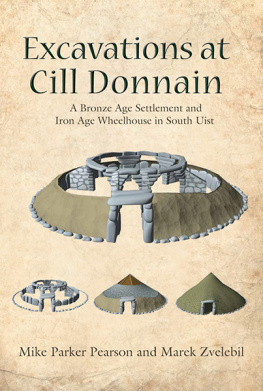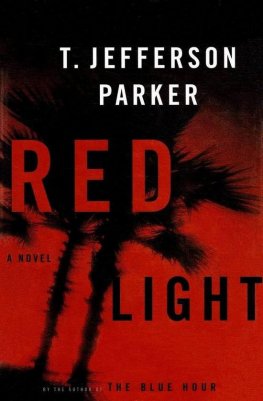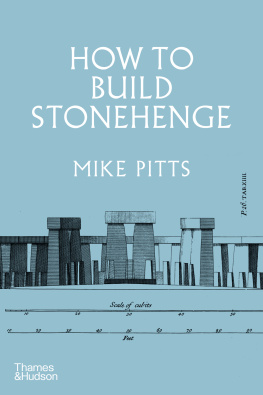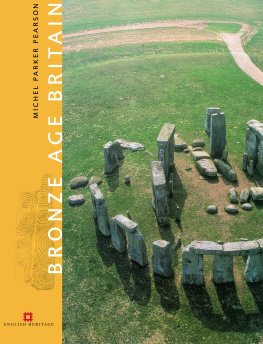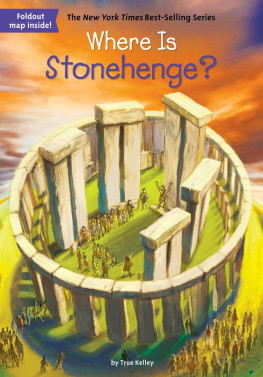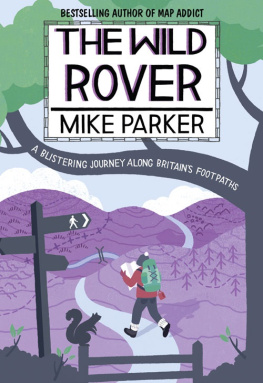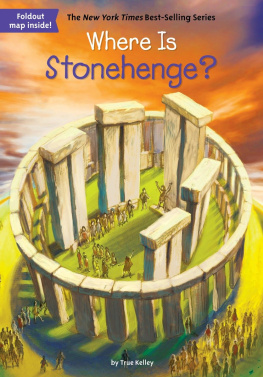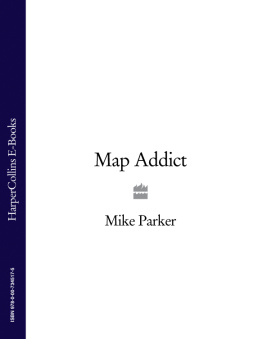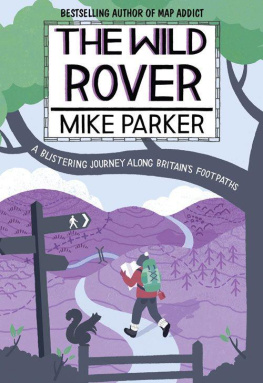Mike Parker Pearson - Stonehenge
Here you can read online Mike Parker Pearson - Stonehenge full text of the book (entire story) in english for free. Download pdf and epub, get meaning, cover and reviews about this ebook. publisher: Simon & Schuster, genre: Religion. Description of the work, (preface) as well as reviews are available. Best literature library LitArk.com created for fans of good reading and offers a wide selection of genres:
Romance novel
Science fiction
Adventure
Detective
Science
History
Home and family
Prose
Art
Politics
Computer
Non-fiction
Religion
Business
Children
Humor
Choose a favorite category and find really read worthwhile books. Enjoy immersion in the world of imagination, feel the emotions of the characters or learn something new for yourself, make an fascinating discovery.
- Book:Stonehenge
- Author:
- Publisher:Simon & Schuster
- Genre:
- Rating:4 / 5
- Favourites:Add to favourites
- Your mark:
- 80
- 1
- 2
- 3
- 4
- 5
Stonehenge: summary, description and annotation
We offer to read an annotation, description, summary or preface (depends on what the author of the book "Stonehenge" wrote himself). If you haven't found the necessary information about the book — write in the comments, we will try to find it.
Stonehenge — read online for free the complete book (whole text) full work
Below is the text of the book, divided by pages. System saving the place of the last page read, allows you to conveniently read the book "Stonehenge" online for free, without having to search again every time where you left off. Put a bookmark, and you can go to the page where you finished reading at any time.
Font size:
Interval:
Bookmark:
EXPLORING THE GREATEST
STONE AGE MYSTERY
ALSO BY MIKE PARKER PEARSON
From Machair to Mountains: Archaological Survey and Excavation in South Uist (2012)
Pastoralists, Warriors and Colonists:
The Archaeology of Southern Madagascar (2010)
Ancient Uists: Exploring the Archaeology of the Outer Hebrides (2008)
From Stonehenge to The Baltic: Living with Cultural Diversity in the 3rd Millennium BC (2007)
Warfare, Violence and Slavery in Prehistory (2005)
South Uist: Archaeology and History of a Hebridean Island (2004)
Fiskerton: An Iron Age Timber Causeway with Iron Age and Roman Votive Offerings: The 1981 Excavations (2004)
Food, Culture and Identity in the Neolithic and Early Bronze Age (2003)
In Search of The Red Slave: Shipwreck and Captivity in Madagascar (2002)
Earthly Remains: The History and Science of Preserved Bodies (2001)
The Archaeology of Death and Burial (1999)
Between Land and Sea:
Excavations at Dun Vulan, South Uist (1999)
Looking at the Land: Archaeological Landscapes in Eastern England:
Recent Work and Future Directions (1994)
Architecture and Order: Approaches to Social Space (1994)
Bronze Age Britain (1993)
New Approaches to our Past: An Archaeological Forum (1978)

First published in Great Britain by Simon & Schuster, 2012
A division of Simon & Schuster UK Ltd
A CBS COMPANY
Copyright 2012 by Mike Parker Pearson
This book is copyright under the Berne Convention.
No reproduction without permission.
All rights reserved.
The right of Mike Parker Pearson to be identified as the author of this work has been asserted by him in accordance with sections 77 and 78 of the Copyright, Designs and Patents Act, 1988.
Simon & Schuster UK Ltd
1st Floor
222 Grays Inn Road
London WC1X 8HB
www.simonandschuster.co.uk
Simon & Schuster Australia, Sydney
Simon & Schuster India, New Delhi
A CIP catalogue record for this book is available
from the British Library.
ISBN: 978-0-85720-730-2
eBook ISBN: 978-0-85720-733-3
Every reasonable effort has been made to contact copyright holders of material reproduced in this book. If any have inadvertently been overlooked, the publishers would be glad to hear from them and make good in future editions any errors or omissions brought to their attention.
Typeset in Baskerville by M Rules
Printed and bound by CPI Group (UK) Ltd, Croydon, CR0 4YY
My co-directors of the Stonehenge Riverside Project were Josh Pollard, Chris Tilley, Julian Thomas, Colin Richards and Kate Welham. We were joined for specific projects in later years by Mike Allen, Wayne Bennett, Charly French, Chris Gaffney, Paul Garwood, Jacqui McKinley, Mike Pitts, Julian Richards, (California) Dave Robinson, Clive Ruggles, Rob Scaife and Armin Schmidt. The long excavation seasons were made possible by the team of supervisors Becca Pullen, Hugo Anderson-Whymark, (Manchester) Dave Aspden, Ben Chan, Ian Heath, Neil Morris, Bob Nunn, Jim Rylatt, Ellen Simmons and Anne Teather who were joined by many hard-working site assistants each year. Amongst these, I need to mention Lizzie Carleton, Chris Caswell, Ralph Collard, C.J. Hyde, (Farmer) Dave Shaw, Susan Stratton and James Thomson, who started as novice undergraduate diggers and ended up training others.
The geophysical surveys and data processing depended on Mark Dover, who managed the digital resource throughout the first stage of the project; from among the many Bournemouth students who undertook the surveys, Lawrence Shaw and Charlene Steele continue to work on aspects of the project. All of the above, especially Hugo, also contributed to the success of some indescribable campsite parties, for which Alistair Pike provided glow-sticks; I imagine there are photographs on Facebook, but I have never dared look.
The student diggers came primarily from the universities of Sheffield, Manchester, Bournemouth, UCLAN, Birmingham, Cardiff, Kalmar, Leicester, Exeter, Plymouth and UCL: they cannot be named individually of course, because we probably trained over 500 undergraduates over the life of the project. As is usual with archaeology students on excavations, the majority enjoyed themselves enormously, a handful appeared to hate the whole experience and a lucky few came back for more year after year. Some of the students took part in visitor guiding and public outreach, an integral part of a project such as this, managed by Megan and David Price and then by Pat Shelley. Adam Stanford of Aerial-Cam took many essential and stunning photographs throughout the project. Helen Wickstead co-ordinated the artists in residence, who are thanked for bringing a new dimension to the project.
The main staffing problem in the later years of the project was having to turn people away we could never accommodate everyone who wanted to volunteer. For those who did, I again cannot mention all by name, but Jane Downes, Duncan Brown, Denise Allen, Win Scutt, David Durkin and all the other volunteers know that their work was much appreciated. Three important volunteers throughout the projects life have been Eileen Parker, Lesley Chapman and Jane Ford, all mature students of archaeology in Sheffield, who continue to dedicate their time, patience and skills to the post-excavation process.
All the landowners and tenant farmers were unfailingly helpful and patient, allowing us access to the sites sometimes over several seasons: we owe a debt of thanks to Sir Edward Antrobus, Richard Bawden, Ian Baxter, Stuart Crook, Mr E. Hann, Billy King, Hugh Morrison, Stan and Henry Rawlins, the Rowlands and Rob Turner in Wiltshire and Huw Davies, the late Iorwerth Williams and the late Hyacinthe Hawkesworth, Lady Marcher of Cemaes, in Pembrokeshire. Chris Gingell and Martin Papworth ran the National Trust side of the necessary permissions, and Amanda Chadburn and Rachel Foster of English Heritage had the unsung task of managing all the paperwork and meetings generated by our research proposals every year; English Heritage also funded two seasons of visitor outreach, co-ordinated by Kath Graham and Lerato Dunn. Dave Field and Martyn Barber at English Heritage have been endlessly helpful and willing to share their research ideas. MoD archaeologists Richard Osgood and Martin Brown are thanked for making arrangements for work on Royal School of Artillery land.
Thanks go to Wessex Archaeology for providing equipment, and support for the flotation programme. Reg Jury provided mechanical excavators, some huge trout and an enormously generous contribution to the diggers beer fund. The Woodbridge Inn in North Newnton housed us every year, the Masseys provided an essential ex-Army marquee, and Rushall Village Hall and Corsham Scouts helped out with domestic equipment. Archaeological projects rely on such local goodwill, and we are tremendously grateful to all concerned.
We also rely on our funding bodies who, we hope, are pleased with the results of this project that they supported for so many years. The major project funder was the Arts and Humanities Research Council, with further grants and awards for different aspects of the overall project provided by the National Geographic Society, the British Academy, the Royal Archaeological Institute, the Society of Antiquaries, Google, the Robert Kiln Trust, Andante Travel and the Royal Society of Northern Antiquaries of Copenhagen. Naomi Nathan, Jo Mirfield and Chris Grimbley in Sheffield were driven to distraction at times by the problems of administering these multiple grants, and Karen and I thank them for their patience in helping sort out our bundles of muddy, dog-eared receipts every year, and in putting together our hired vans and fieldwork equipment.
Font size:
Interval:
Bookmark:
Similar books «Stonehenge»
Look at similar books to Stonehenge. We have selected literature similar in name and meaning in the hope of providing readers with more options to find new, interesting, not yet read works.
Discussion, reviews of the book Stonehenge and just readers' own opinions. Leave your comments, write what you think about the work, its meaning or the main characters. Specify what exactly you liked and what you didn't like, and why you think so.

